It is one thing to grow a small veggy patch out the front door of a rental house add a bit of mulch, some manure, a few plants, seeds, water and enjoy. The evolution of a large permanent garden is a whole other exercise in muscles, machines (if you have them), planning and time. The garden at the Rivertree homestead is located approximately six meters to the down slope side of the swale( that was established several weeks ago). The hope is that the garden will benefit from being on the down slope of the swale. This is an account of the design and implementation of the Rivertree veggy garden.
The line of string on the right indicates the placement of a future fence to keep out the local rabbit and Kangaroo/Wallaby population. Using a laser level it is pegged to the natural contour of the land the remainder of the garden was designed square to this line. The garden covers an area of approximately 240 square meters, of which 70 are dedicated to pathways.
First, a string was placed to mark the edges of a pathway. In the proccess of this type of garden construction, material is removed from between the two lines and placed on either side to form the raised beds. Second, there is an application of blood and bone meal fertilizer that provides a young garden with vital nutrients and helps kick start soil biology. It is applied before the beds are dug, and is incorported as the digging takes place.
These tools would find themselves permanently glued to our hands for many days. We did use the excavator to do the bulky rough work, but the majority of the effort was spent on more deatailed work that only hand tools could do. When we started, Jesse and I did not fully realize how much we were in for physically.
The initial dig, with the excavator, is to an average depth of .5m. On either side of the trench the beds begin to form with the excess material. As with most water efficient design, it is important to keep pathways and beds dead level. We should have been checking the trench for level as we went along but we didn't. The paths were dug to a consistent average depth, but they were not marked on contour and therefore it produced a 20cm difference in elevation from one end of the garden to the other. With that much elevation change in the pathways water will collect at the low end creating a soggy area and at the high end the garden beds would be dry making it difficult to water consitently. Obviously this was a really big mistake and by the time we had noticed all the trenches had been dug.
We have a bit of a melt down at this point, because we have recognized our mistake and we are already very tired. In order to correct the problem we had to move around a lot of extra material by hand meaning the lessons of this experience will not soon be forgotten.
To lift our spirits we went to the Tip and did some garbage picking. Notice the giant bird net in the background. We were on a hunt for cardboard and other resources to be rescued from the Tip and used to help create a bountiful garden.
This is the first time in our lives we went home from the garbage dump with more than when we arrived.
In the distance rests 30 cubic meters of crushed limestone. Behind the photographer is the garden for which it was destine.
The paths were lined with a thick layer of cardboard and filled with the crushed limestone hauled wheelbarrow by wheelbarrow up the hill. The gravel filled pathways will function as both drainage and water catchment systems. In theory, these beds will be both moist and well drained using this pathway design.
As the pathways were filled, a width of .80m was maintained using a measured length of wood, and the laser was used to ensure that dead level was maintained.
The cardboard is used as a biodegradable weed barrier at the edge of the garden pathways. Persistent weed problems always occur at the edges, like the base of a fence post or crack in the sidewalk. The buried cardboard will prevent weeds for several weeks, but not permanently. It is important to plant something in this part of the bed soon. Pennyroyal is a favorite for its pleasing smell and ability to distract pests.
There it is!!! The completed garden. We are very happy with our effort and persistence and the garden is going to be very productive in the future. All we need now is a few thousand plants!
Will run-away climate change make drought permanent?
18 years ago
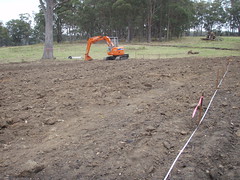
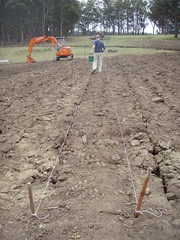
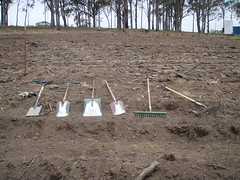


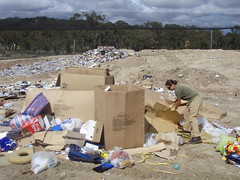





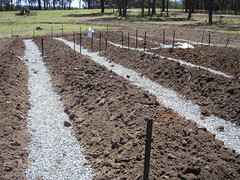




2 comments:
That's interesting stuff.
Will you be putting edges on your garden beds? In my little backyard, I found that makes it a lot easier to control weeds, and in case of rainstorm which might spread the soil out into the pathways, but of course as you say, doing it large-sclae can be different...?
Hallo Jesse & Tanya
I agree with Kiashu, I too do a little gardening! I know they are not easy to find but old railway sleepers are ideal for making borders/kerbing. A disadvantage of course is that they use up a lot of space.
After what happened to the last kangaroo, I do not think you will be having any trouble with them in the garden ;-)
Love reading your blog. Keep up the good work.
Post a Comment